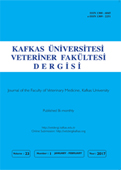
This journal is licensed under a Creative Commons Attribution-NonCommercial 4.0 International License
Kafkas Üniversitesi Veteriner Fakültesi Dergisi
2018 , Vol 24 , Issue 1
The Role of Cuttlebone and Cuttlebone Derived Hydroxyapatite with Platelet Rich Plasma on Tibial Bone Defect Healing in Rabbit: An Experimental Study
1Department of Clinical Science, Faculty of Specialized Veterinary Sciences, Science and Research Branch, Islamic Azad University, Tehran - IRAN2Department of Marine Biology, Graduate School of Marine Science and Technology, Science and Research Branch, Islamic Azad University, Tehran - IRAN
3Pediatric Urology Research Center, Department of Pediatric Urology, Pediatrics Center of Excellence, Tehran University of Medical Sciences, Tehran - IRAN DOI : 10.9775/kvfd.2017.18444 Today marine-derived biologic scaffolds are popular due to their biocompatibility and high regenerative potential. Previous studies prepared hydroxyapatite from cuttlebone, the internal shell of cuttlefish; However, its biocompatibility and bioactivity has not been fully studied especially in-vivo. The aim of this study was to evaluate cuttlebone-derived hydroxyapatite in-vivo potential and possible synergistic effect of platelet rich plasma with this scaffold in promoting bone healing. Hydroxyapatite was prepared from cuttlebone (Sepia officinalis) via hydrothermal transformation. The conversion and microstructure of prepared material was assessed by scanning electron microscopy (SEM) and x-ray diffraction (XRD) analysis. Fifteen male white New Zealand rabbits were randomly divided to 6 groups each containing 5 limbs. In order to reduce sample size right and left pelvic limbs of rabbits were used as separate groups. Full thickness bi-cortical defects were created bilaterally in proximal tibia. The defect was left untreated in negative control group. In experimental group I to V the defect was filled with platelet rich plasma, raw cuttlebone, raw cuttlebone combined with platelet rich plasma, cuttlebone derived hydroxyapatite and cuttlebone derived hydroxyapatite combined with platelet rich plasma, respectively. Histopathological evaluation was performed on specimens received on day 56. Bone healing was assessed according to union, spongiosa, cortex and bone marrow indices. Our results demonstrated that Group I was superior to negative control group in defined indices. Groups IV and V showed preferable outcomes regarding to union and cortex indices in comparison to groups II and III. Also acceptable degree of spongiosa formation was observed in all groups. Cuttlebone derived hydroxyapatite could be an appropriate biomaterial to stimulate bone formation and enhance bone regeneration. Furthermore platelet rich plasma was successful in advancement of bone marrow formation. Keywords : Bone defect, Cuttlebone, Hydroxyapatite, Platelet rich plasma, Rabbit










